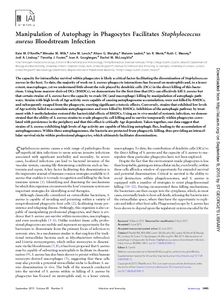O'Keeffe, KM;
Wilk, MM;
Leech, JM;
Murphy, AG;
Laabei, M;
Monk, IR;
Massey, RC;
Lindsay, JA;
Foster, TJ;
Geoghegan, JA;
et al.
O'Keeffe, KM; Wilk, MM; Leech, JM; Murphy, AG; Laabei, M; Monk, IR; Massey, RC; Lindsay, JA; Foster, TJ; Geoghegan, JA; McLoughlin, RM
(2015)
Manipulation of Autophagy in Phagocytes Facilitates Staphylococcus aureus Bloodstream Infection.
Infect Immun, 83 (9).
pp. 3445-3457.
ISSN 1098-5522
https://doi.org/10.1128/IAI.00358-15
SGUL Authors: Lindsay, Jodi Anne
![[img]](https://openaccess.sgul.ac.uk/107484/1.hassmallThumbnailVersion/Infect.%20Immun.-2015-O%27Keeffe-3445-57.pdf)  Preview |
|
["document_typename_cannot open `/data/SGUL/sgul/eprints3/archives/sgul/documents/disk0/00/10/74/84/01/Infect.' (No such file or directory)
cannot open `Immun.-2015-O=0027Keeffe-3445-57.pdf' (No such file or directory)" not defined]
Published Version
Available under License Creative Commons Attribution.
Download (1MB)
| Preview
|
Abstract
The capacity for intracellular survival within phagocytes is likely a critical factor facilitating the dissemination of Staphylococcus aureus in the host. To date, the majority of work on S. aureus-phagocyte interactions has focused on neutrophils and, to a lesser extent, macrophages, yet we understand little about the role played by dendritic cells (DCs) in the direct killing of this bacterium. Using bone marrow-derived DCs (BMDCs), we demonstrate for the first time that DCs can effectively kill S. aureus but that certain strains of S. aureus have the capacity to evade DC (and macrophage) killing by manipulation of autophagic pathways. Strains with high levels of Agr activity were capable of causing autophagosome accumulation, were not killed by BMDCs, and subsequently escaped from the phagocyte, exerting significant cytotoxic effects. Conversely, strains that exhibited low levels of Agr activity failed to accumulate autophagosomes and were killed by BMDCs. Inhibition of the autophagic pathway by treatment with 3-methyladenine restored the bactericidal effects of BMDCs. Using an in vivo model of systemic infection, we demonstrated that the ability of S. aureus strains to evade phagocytic cell killing and to survive temporarily within phagocytes correlated with persistence in the periphery and that this effect is critically Agr dependent. Taken together, our data suggest that strains of S. aureus exhibiting high levels of Agr activity are capable of blocking autophagic flux, leading to the accumulation of autophagosomes. Within these autophagosomes, the bacteria are protected from phagocytic killing, thus providing an intracellular survival niche within professional phagocytes, which ultimately facilitates dissemination.
Statistics
Item downloaded times since 11 Apr 2017.
Actions (login required)
 |
Edit Item |



